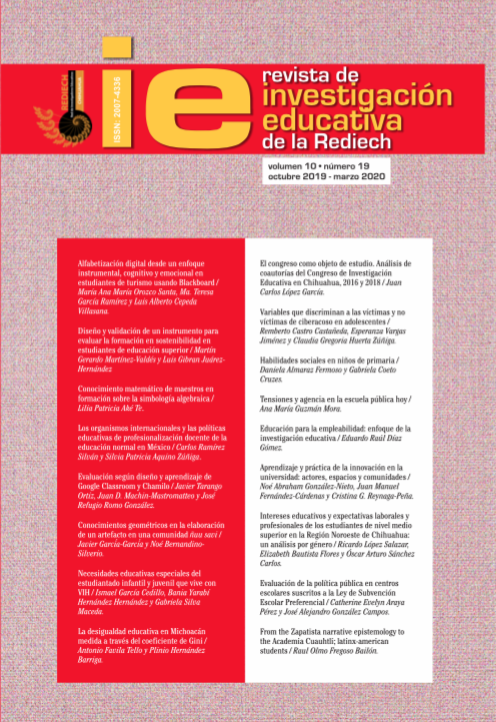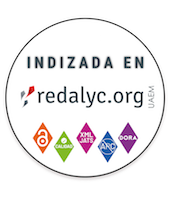Mathematical knowledge of training teachers in algebraic symbology
DOI:
https://doi.org/10.33010/ie_rie_rediech.v10i19.506Keywords:
symbolism, algebraizing, training teachers, elementary schoolAbstract
The use of symbols and letters in secondary education is considered one of the obstacles in learning algebra, justified by the almost nonexistent understanding of the manipulation of algebraic symbolism. This is one of the reasons that prompted the initiative for the development of forms of algebraic thinking in primary education, seeking to favor the transition to secondary school mathematics by explicitly explaining the algebraic nature of basic mathematics. However, this implies training teachers at this educational level to face this introduction and development. The qualitative and exploratory study reported provides evidence of the mathematical activity that future teachers in training perform when solving tasks that involve algebraic symbolism. Analysis criteria related to relational thinking and meaning of literals were used to describe and categorize said mathematical activity. The results indicate that future teachers resort more frequently to particular cases and specific operations to tackle the tasks. This implies a change in the mathematical framework that teachers develop during their training.
References
Asquith, P., Stephens, A., Knuth, E. y Alibali, M. (2007). Middle school mathematics teachers’ knowledge of students’ understanding of core algebraic concepts: equal sign and variable. Mathematical Thinking and Learning, 9(3), 249-272.
Blanton, M.L. y Kaput, J.J. (2003). Developing elementary teachers’ algebra eyes and ears: Understanding characteristics of professional development that promote generative and self-sustaining change in teacher practice. Teaching Children Mathematics, (10), 70-77.
Booth, L.R. (1984). Algebra: Children’s strategies and errors. Windsor, UK: NFER-Nelson.
Butto, C. y Rojano, T. (2004). Introducción temprana al pensamiento algebraico: abordaje basado en la geometría. Educación Matemática, 16(1), 113-148.
Burkardt, H. (2001). Algebra for all: ¿What does it mean? How are we doing? In H. Chick, K. Stacey, J. Vincent y J. Vincent (eds.), The future of the teaching and learning of algebra (vol. 1, pp. 140-146). Melbourne, Australia: University of Melbourne.
Cai, J. y Knuth, E. (2011). Early algebraization: A global dialogue from multiple perspec¬tives. Heidelberg, Alemania: Springer.
Capraro, M., Rangel-Chavez, A. y Capraro, R. (2008). Effective preparation for teaching of algebra at the primary level. The 11th International Conference on Mathematics Education -ICME 11- for Topic Study Group 2: New developments and trends in mathematics education at primary level. Monterrey, México.
Carpenter, T.P., Franke, M.L. y Levi, L. (2003). Thinking mathematically. Integrating arithmetic and algebra in elementary school. Portsmouth, N.H.: Heinemann.
Carpenter T.P., Levi, L., Franke, M.L. y Zeringue, J.K. (2005). Algebra in elementary school: Developing relational thinking. Zentralblatt für Didaktik der Mathematik - ZDM: The International Journal on Mathematics Education, (37), 53-59.
Carraher, D.W. y Schliemann, A.L. (2007). Early Algebra and Algebraic Reasoning. En F. Lester (ed.), Second handbook of research on mathematics teaching and learning (vol. 2, pp. 669-705). Charlotte, N.C.: Information Age Publishing, NCTM.
Castro, W.F., Martínez-Escobar, J.D. y Pino-Fan, L.R. (2017). Niveles de algebrización de la actividad matemática escolar: análisis de libros de texto y dificultades de los estudiantes. Journal of Research in Mathematics Education, 6(2), 164-191.
Chapa, M.C. y Fahara, M.F. (2015). La formación inicial de profesores en las escuelas normales. IE Revista de Investigación Educativa de la Rediech, 6(10), 28-35.
Cooper, T. y Warren, E. (2011). Years 2 to 6 students’ ability to generalise: Models, representations and theory for teaching and learning. En J. Cai y E. Knuth (eds.), Early algebraization. Advances in mathematics education (pp. 187-211). Berlín, Alemania: Springer.
Figueroa-Millán, L. M. (2000). La formación de docentes en las escuelas normales: entre las exigencias de la modernidad y las influencias de la tradición. Revista Latinoamericana de Estudios Educativos, 30(1), 117-142.
Ferrero, L. (2007). Sexto de primaria: tercer ciclo. Matemáticas. Madrid: Anaya.
Gallardo, J. (2004). Diagnóstico y evaluación de la comprensión del conocimiento matemático. El caso del algoritmo estándar escrito para la multiplicación de números naturales (tesis doctoral no publicada). Universidad de Málaga, España.
Kaput, J.J. (2000). Transforming algebra from an engine of inequity for an engine of mathematical power by “algebraizing” the K-12 curriculum. Dartmouth, MA: NCTM, National Academy Press.
Kieran, C. (2007). Learning and teaching algebra at the middle school through college levels. Building meaning for symbols and their manipulation. En F. Lester (ed.), Second handbook of research on mathematics teaching and learning (vol. 2, pp. 707-762). Charlotte, NC: Information Age Publishing Inc., NCTM.
Kieran, C. (2017). Teaching and learning algebraic thinking with 5-to 12-year-old: The global evolution of an emerging field of research and practice. Nueva York: Springer.
Kieran, C., Pang, J., Schifter, D. y Fong, S. (2016). Early algebra. Research into its nature, its learning, its teaching. Hamburgo, Alemania: Springer.
Küchemann, D. (1978). Children’s understanding of numerical variables. Mathematics in School, 7(4), 23-26.
Kızıltoprak, A. y Yavuzsoy Köse, N. (2017). Relational thinking: The bridge between arithmetic and algebra. International Electronic Journal of Elementary Education, 10(1), 131-145.
Knuth, E.J., Alibali, M.W., McNeil, N.M., Weinberg, A. y Stephens, A.C. (2005). Middle school students’ understanding of core algebraic concepts: Equivalence y variable 1. Zentralblatt für Didaktik der Mathematik (ZDM): The
International Journal on Mathematics Education, 37(1), 68-76.
National Council of Teachers of Mathematics. (2000). Principles and Standards for School Mathematics. Reston, VA: NCTM.
Stephens, M. y Ribeiro, A. (2012). Working towards algebra: The importance of relational thinking. Revista Latinoamericana de Investigación en Matemática Educativa (RELIME), 15(3), 373-402.
Secretaría de Educación Pública. (2012). Plan de estudios de la licenciatura en educación primaria. México: Dirección General de Educación Básica / SEP.
León, O.G. y Montero, I. (2003). Métodos de investigación en psicología y educación. España: McGraw-Hill.
Lins, R. y Kaput, J.J. (2004). The early development of algebraic reasoning: The current state of the field. En K. Stacey, H. Chick y M. Kendal (eds.), The future of the teaching and learning of algebra. The 12th International Conference on Mathematics Instruction (ICMI) (pp. 47-70). Norwood, MA: Kluwer Academic Publishers.
Molina, M. (2009). Una propuesta de cambio curricular: integración del pensamiento algebraico en educación primaria. PNA: Revista de Investigación en Didáctica de la Matemática, 3(3), 135-156.
Puig, L. y Rojano, T. (2004). The history of algebra in mathematics education. En K. Stacey, H. Chick y M. Kendal (Eds.), The teaching and learning of algebra. The 12th International Commission on Mathematical Instruction (ICMI) (pp. 189- 224). Norwood, MA: Kluwer Academic Publishers.
Schliemann, A.D., Carraher, D.W. y Brizuela, B. (2007). Bringing out the algebraic character of arithmetic: From children’s ideas to classroom practice. Hillsdale, MI: Lawrence Erlbaum Associates.
Usiskin, Z. (1989). Conceptions of school algebra and uses of variables. En A.F. Coxford (ed.), The ideas of algebra K-12 (pp. 8-19). Reston, VA: NCTM.
Vasilachis, I. (2009). Estrategias de investigación cualitativa. España: Gedisa.
Warren, E. (2003). The role of arithmetic structure in the transition from arithmetic to algebra. Mathematics Education Research Journal, 15(2), 122-137.
Whitacre, I., Schoen, R.C., Champagne, Z. y Goddard, A. (2017). Relational thinking: What’s the difference? Teaching Children Mathematics, 23(5), 302-308.




















